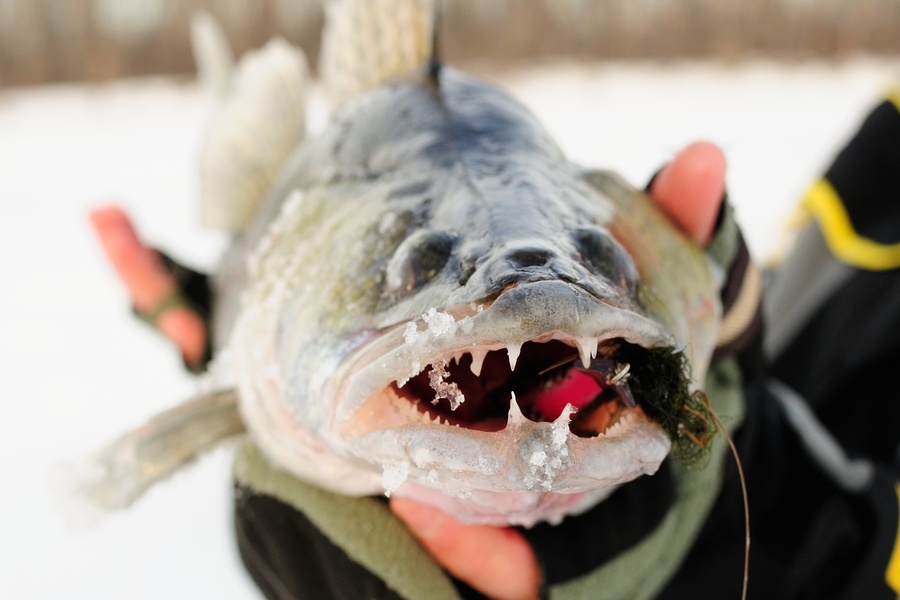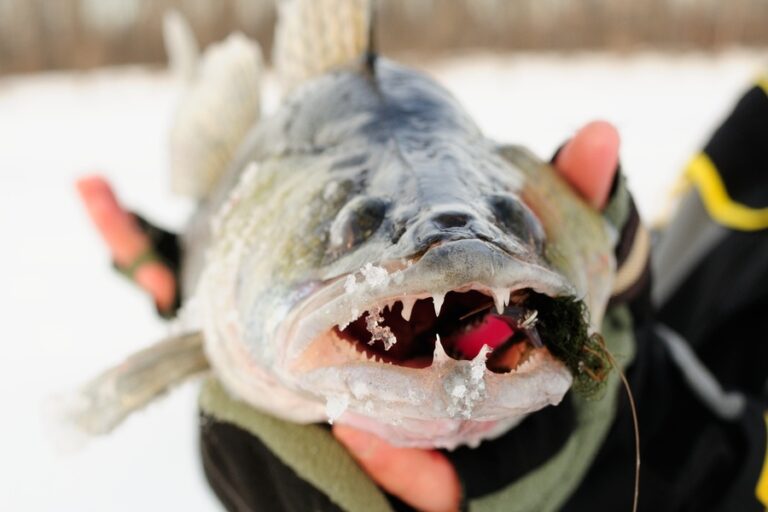Are Walleye Dangerous? (Teeth, Gills, Spines, Mercury, etc)
Walleye are not considered dangerous to humans. While they have sharp teeth and gill covers, along with spiny fins that can cause minor injuries to anglers during handling, they do not exhibit aggressive behavior towards people and are safe to handle with care.
| Danger Posed by Walleye to Anglers | Description | Prevention Methods |
|---|---|---|
| Cuts from Teeth | Walleye have sharp teeth that can cause cuts when handling, especially during unhooking. | Use fishing gloves and tools like needle-nose pliers for unhooking. |
| Puncture Wounds from Fin Spines | The spiny dorsal fins of walleye can cause puncture wounds. | Handle the fish carefully, avoiding direct contact with the spines; use a fish gripper if necessary. |
| Accidental Hook Injuries | Hooks can embed in the angler’s skin when a walleye struggles or flips during unhooking. | Keep a firm grip on the fish, use dehooking tools, and avoid placing hands near the mouth when unhooking. |
| Injuries from Gills | The gills of walleye are sharp and can cut hands or fingers if touched. | Avoid holding walleye by the gills; instead, support the fish’s body when handling. |
| Eye Injuries | Rare but possible if a walleye thrashes while close to the angler’s face. | Maintain a safe distance from the face while handling; wear sunglasses or protective eyewear. |

Table of Contents
Are Walleye Aggressive towards People?
Walleye are not typically aggressive towards people. They are primarily focused on feeding on smaller fish and generally do not exhibit aggressive behavior towards humans. While handling, they might react defensively, especially when being unhooked, but this is more about self-preservation rather than aggression. In a natural setting, walleye do not pose a threat to people.
Dangers Posed by Walleye
Sharp Spines
Walleye do have sharp fin spines, particularly on their dorsal fins, which are located along their backs. These spines can cause injury if they penetrate the skin, leading to painful puncture wounds. However, it’s important to note that these spines are not venomous.
While walleye are generally not aggressive towards humans, their anatomy presents some risks if not handled with care. In addition to their sharp dorsal fin spines, walleye also have sharp teeth that can cause injuries if a person’s hands or fingers come into contact with them. It is crucial to exercise caution when unhooking or handling these fish to avoid accidental bites.
To safely handle a walleye and avoid their spines, it is recommended to slide your hand down from their head to their back when you grab them. For smaller walleye, you can hold them vertically without causing any harm, but you should not “lip” them due to their sharp teeth.
Using proper tools, like fish grips or pliers, can also help to safely handle walleye and minimize the risk of injury from their teeth or spines. Injuries caused by walleye teeth or dorsal fin spines can potentially become infected if not treated properly.
Like any puncture wound, these injuries have the potential to introduce bacteria into the body, increasing the risk of infection. Therefore, prompt cleaning and appropriate medical attention should be sought if an injury occurs during the handling of walleye.
For a complete breakdown on what walleye eat, check out this helpful guide.
Gill Covers
Walleye do have sharp gill covers also referred to as gill plates or gill flaps. The edges of these gill covers are razor-sharp, and they can cause cuts if not handled with care. Walleye can flare these gill covers out when handled making them more likely to cut you.
Therefore, when handling a walleye, it is recommended to grasp the fish by the body, behind the gill plates. This helps to avoid injury from the sharp gill covers as well as from the walleye’s sharp teeth and dorsal fin spines.
Unlike most other fish, I would not recommend you hold a walleye by the gills. The sharp gill covers pose a significant danger and any thrashing by the fish or slip from your hand could leave you with a nasty cut.
Are Walleye Safe to Consume?
Walleye are generally safe to eat and offers numerous health benefits. It is an excellent source of protein, healthy fats, and vitamin D. However, walleye can contain contaminants such as mercury, which can pose health risks if consumed in large amounts.
The mercury levels in walleye can vary based on factors such as the fish’s size and the specific body of water from which it was caught. Larger walleye tend to have higher mercury concentrations than smaller ones. Certain bodies of water may also have higher levels of mercury contamination, leading to higher mercury levels in the fish from those waters.
The recommended consumption of walleye can vary depending on the source. For example, it is suggested that Lake Erie walleye can be safely consumed once a week. The Minnesota Department of Health suggests a range from two meals per week to one meal per month, depending on the size of the walleye. It’s important to check local advisories or guidelines for the most accurate and up-to-date information.
To minimize the risk of mercury exposure when eating walleye, you can:
- Choose smaller walleye, as they tend to have lower mercury levels.
- Diversify your diet with other types of fish that are known to have lower mercury levels.
- Follow local fish consumption advisories or guidelines.
When preparing walleye for consumption, ensure that it is cooked thoroughly to kill any potential pathogens. You can grill, bake, or fry the fish based on your preference. Always handle raw fish with clean hands and utensils to prevent cross-contamination.
Remember, while walleye is generally safe to eat, individuals with specific dietary needs or health concerns, such as pregnant women or young children, should consult with a healthcare provider before consuming fish with potential mercury contamination.
Frequently Asked Questions
What are the most common injuries to anglers caused by walleye while being handled?
Anglers handling walleye commonly face injuries such as minor bites from the fish’s sharp teeth, cuts from their gills, and puncture wounds from their spiny dorsal fins. Additionally, struggling walleyes can cause accidental hook injuries, embedding hooks into the angler’s skin. To minimize these risks, using tools like needle-nose pliers for unhooking, wearing protective gloves, and handling the fish carefully are recommended best practices.
Do walleye lose and regrow their teeth?
Walleye do lose their teeth and can regrow their teeth. Like many fish, walleye have the ability to shed and replace lost teeth throughout their lives. This process ensures that they maintain effective teeth for capturing and holding prey. The regrowth of teeth is a natural and ongoing process for walleye. That’s pretty cool, right?
Can Walleye Bites Cause Injuries?
While walleye bites are not common, they can cause minor injuries like cuts or nicks, especially when anglers are removing hooks or handling the fish carelessly.
Do Walleye Have Venomous Fins or Spines?
Walleye do not have venomous fins or spines. Their fins, particularly the dorsal fin, have sharp spines that can cause puncture wounds, but they are not venomous. Just be careful handling these fish. I have been poked more than my fair share over the years by poorly handled walleye.
Is it safe to hold walleye by the gills?
It is not recommended to hold walleye by the gills. This method can harm the fish and also poses a risk of cuts to the angler due to the sharp gill plates.





